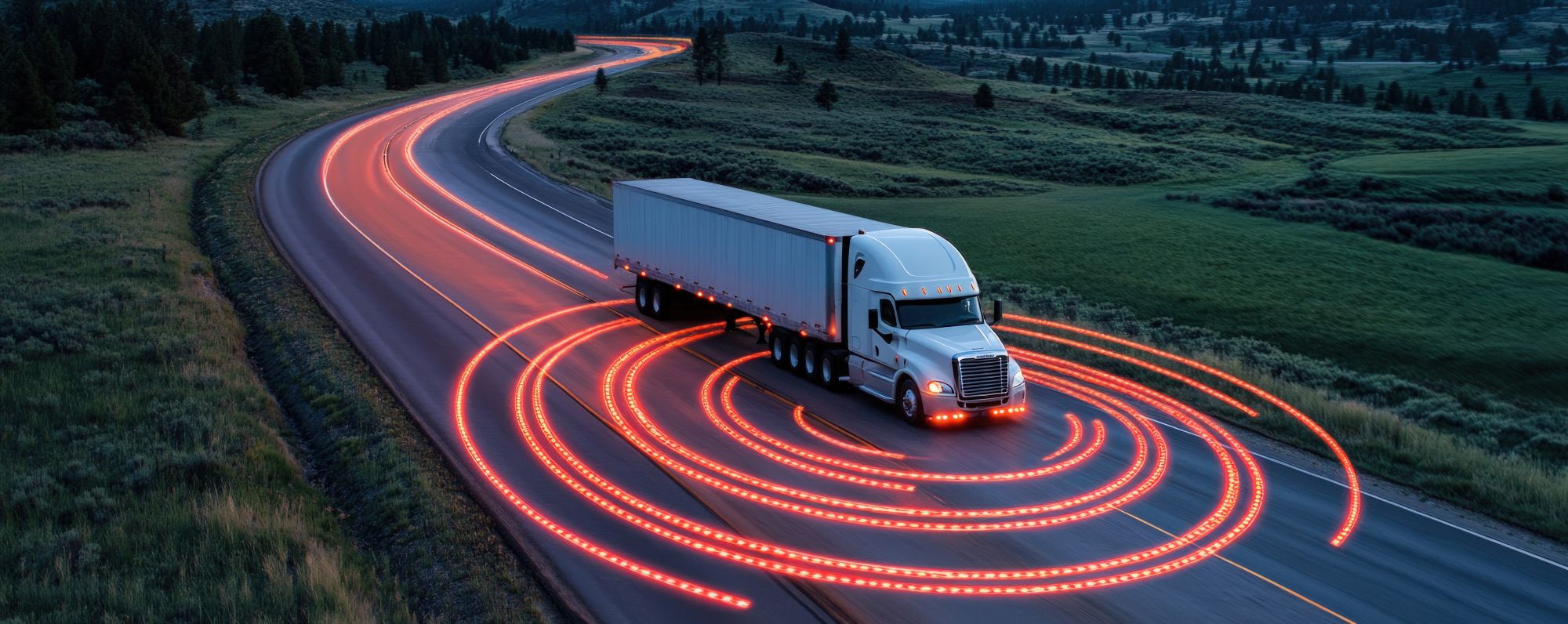
Susie Jones
Autonome vrachtwagens: De weg voor ons ontwarren
Gemaakt: 16-05-2025
•
Bijgewerkt: 23-05-2025
Autonome vrachtwagens - een afschrikwekkend idee voor sommigen, maar schijnbaar de toekomst van de logistieke sector. Naarmate de technologie in de sector voortschrijdt, is het vooruitzicht groot dat gedeeltelijk of volledig autonome voertuigen uw goederen komen afleveren. Volgens de Britse regering zou dit zelfs al in 2026 kunnen gebeuren, aangezien in mei 2024 de Automated Vehicles (AV) Act (wet geautomatiseerde voertuigen) in werking is getreden.
Maar wat gebeurt er als een autonome vrachtwagen een ongeluk krijgt? Wie is aansprakelijk? In deze blog duiken we in de wereld van autonomie, hoe het de mobiliteitssector kan beïnvloeden, wie aansprakelijk is bij ongevallen en wat chauffeurs van de verandering vinden.
Wat zijn de verschillende automatiseringsniveaus?
Er zijn zes automatiseringsniveaus:
Niveau 0 - Geen automatisering. De mens voert alle rijtaken uit.
Niveau 1 - Bestuurdersassistentie. Het voertuig beschikt over één geautomatiseerd systeem.
Niveau 2 - Gedeeltelijke automatisering. Het voertuig kan sturen en accelereren. Een mens controleert echter nog steeds alle taken en kan te allen tijde de controle overnemen.
Niveau 3 - Voorwaardelijke automatisering. Het voertuig kan de meeste rijtaken uitvoeren. Er is echter nog steeds menselijke hulp nodig.
Niveau 4 - Hoge automatisering. Geofencing is vereist en het voertuig kan alle rijtaken uitvoeren onder specifieke omstandigheden. Menselijke bediening is een optie.
Niveau 5 - Volledige automatisering. Het voertuig voert alle rijtaken onder alle omstandigheden uit. Er is geen menselijke aandacht of interactie vereist.
Hoe werken autonome trucks?
Dankzij sensoren, camera's en kunstmatige intelligentie kunnen autonome vrachtwagens zelfstandig rijden. Geavanceerde programma's nemen beslissingen in plaats van menselijke bestuurders.
De problemen waar de industrie mee te maken kan krijgen
Juridische aspecten - Wie is aansprakelijk bij ongevallen? Is het de bestuurder, zijn werkgever of het onderhoudsbedrijf? Daar gaan we hieronder dieper op in.
Infrastructuur - Onze bestaande wegen zijn gebouwd voor een wereld met benzinemotoren. Daarom moet de infrastructuur worden opgewaardeerd of vervangen om wagenparken met zelfrijdende auto's te ondersteunen, wat geld en een aanzienlijke hoeveelheid politieke wil vereist.
Maatschappelijke verschuivingen - De houding van het publiek moet ook veranderen. Het vooruitzicht van AI-voertuigen is voor velen ontmoedigend, met zorgen over de veiligheid, het volgen van reizen en de juridische grijze gebieden met betrekking tot verkeersongevallen.
Beveiliging - Een systeem dat vertrouwt op digitale netwerken wordt kwetsbaarder voor cyberbedreigingen.
(https://prodsnapstorage.blob.core.windows.net/public-news/bafaef7e-f4e8-4d78-badb-de2cece2503f-AdobeStock_1275665571.jpg)
Wat vinden vrachtwagenchauffeurs van autonome trucks?
De veiligheid van autonome trucks is een veelbesproken onderwerp binnen de sector, waarbij velen debatteren over de vraag of de technologie op een betrouwbaar niveau is om om te gaan met onvoorspelbaar weer en obstakels te herkennen - iets waar vrachtwagenchauffeurs zich zorgen over maken op de sociale mediapagina's van SNAP:
"Bij het minste beetje regen verliest mijn truck alle automatische mogelijkheden, AEBS en cruisecontrol. Op geen enkele manier mogen vrachtwagens binnenkort zelf rijden zonder chauffeur."
"Dit zal meer mensen op de weg doden en meer files veroorzaken. Bedenk eens hoe betrouwbaar de elektronica van je Euro 6-voertuig is. Dezelfde mensen maken autonome vrachtwagens."
Juridische aspecten - wie is verantwoordelijk bij ongevallen?
Bij een ongeval kan de verantwoordelijkheid verschuiven tussen de bestuurder en de fabrikant. De rechtbank moet bepalen of een ongeluk werd veroorzaakt door een technische fout, onvoldoende onderhoud of een fout van de bestuurder.
Aansprakelijkheid fabrikant
Een fabrikant is aansprakelijk in de volgende gevallen: - Sensorstoring
Softwarefouten
Inadequate cyberbeveiligingsmaatregelen
Onvoldoende testen
Aansprakelijkheid bestuurder/vloot
Een bestuurder van een autonome vrachtwagen kan aansprakelijk zijn voor een ongeval als hij de service of het onderhoud verwaarloost die nodig zijn om het voertuig goed te laten werken - je zou kunnen stellen dat deze aansprakelijkheid ook bij wagenparkbeheerders kan liggen.
Desondanks heerst er nog steeds enige verwarring in de mobiliteitssector. We vroegen vrachtwagenchauffeurs op onze sociale mediapagina's wie volgens hen aansprakelijk zou zijn in het geval van een ongeluk met een autonoom voertuig. 51% van de chauffeurs dacht dat de chauffeur verantwoordelijk zou zijn, 37% suggereerde fabrikanten van geautomatiseerde vrachtwagens en 12% geloofde in softwareontwikkelaars.
Het is duidelijk dat er meer duidelijkheid nodig is onder de mensen in de sector voordat autonome trucks een vast onderdeel worden van onze wegen.
Hoe ziet de toekomst eruit?
In hun vernieuwde TruckPark van de toekomst campagne kijkt SNAP naar de toekomst van de mobiliteitssector. Naarmate de technologie voortschrijdt, zullen autonome voertuigen een belangrijke rol spelen in de sector, met een kans van 50% dat machines alle menselijke banen kunnen overnemen in de komende 120 jaar.
Maar hoe gaan ze om met enkele van de gevaarlijkste snelwegen van Europa?
Vrachtwagenchauffeur zijn is meer dan achter het stuur zitten - het gaat vaak om het navigeren door steeds veranderende en onvoorspelbare wegomstandigheden. Het is de vraag of autonome vrachtwagens de slechtste wegen in Europa aankunnen. In hun meest recente campagne, [Hazardous Highways] (https://snapacc.com/hazardous-highways/), heeft SNAP de gevaarlijkste wegen van Europa geïdentificeerd, waarbij Bulgarije, Litouwen en Tsjechië als meest zorgwekkende naar voren kwamen.
Je zou kunnen stellen dat autonome vrachtwagens voor uitdagingen zullen komen te staan wanneer ze over sommige van deze wegen proberen te navigeren zonder menselijke interactie. Beperkte GPS-nauwkeurigheid, sensorinterferentie en een gebrek aan consistente infrastructuur kunnen de zaken bemoeilijken.



